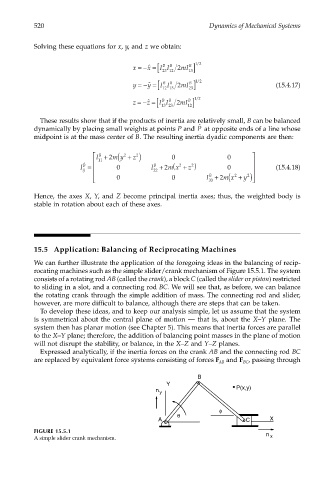Page 539 - Dynamics of Mechanical Systems
P. 539
0593_C15_fm Page 520 Tuesday, May 7, 2002 7:05 AM
520 Dynamics of Mechanical Systems
Solving these equations for x, y, and z we obtain:
/
B
B
x ˆ I I B 2 mI ] 12
x =− =[ 23 12
13
/
B
y ˆ B B mI ] 12
I I
y =− =[ 12 13 2 (15.4.17)
23
/
z ˆ I I B 2 mI ] 12
B
B
z =− =[ 13 23
12
These results show that if the products of inertia are relatively small, B can be balanced
ˆ
P
dynamically by placing small weights at points P and at opposite ends of a line whose
midpoint is at the mass center of B. The resulting inertia dyadic components are then:
m y + )
I + ( 2 z 2 0 0
B
2
11
(
B ˆ
I = 0 I + 2 m x + ) 0 (15.4.18)
2
2
B
z
ij 22
m x + )
I + ( 2 2
B
0 0 33 2 y
Hence, the axes X, Y, and Z become principal inertia axes; thus, the weighted body is
stable in rotation about each of these axes.
15.5 Application: Balancing of Reciprocating Machines
We can further illustrate the application of the foregoing ideas in the balancing of recip-
rocating machines such as the simple slider/crank mechanism of Figure 15.5.1. The system
consists of a rotating rod AB (called the crank), a block C (called the slider or piston) restricted
to sliding in a slot, and a connecting rod BC. We will see that, as before, we can balance
the rotating crank through the simple addition of mass. The connecting rod and slider,
however, are more difficult to balance, although there are steps that can be taken.
To develop these ideas, and to keep our analysis simple, let us assume that the system
is symmetrical about the central plane of motion — that is, about the X–Y plane. The
system then has planar motion (see Chapter 5). This means that inertia forces are parallel
to the X–Y plane; therefore, the addition of balancing point masses in the plane of motion
will not disrupt the stability, or balance, in the X–Z and Y–Z planes.
Expressed analytically, if the inertia forces on the crank AB and the connecting rod BC
are replaced by equivalent force systems consisting of forces F and F , passing through
AB BC
B
Y
n P(x,y)
y
φ
θ
A C X
FIGURE 15.5.1 n
A simple slider crank mechanism. x

